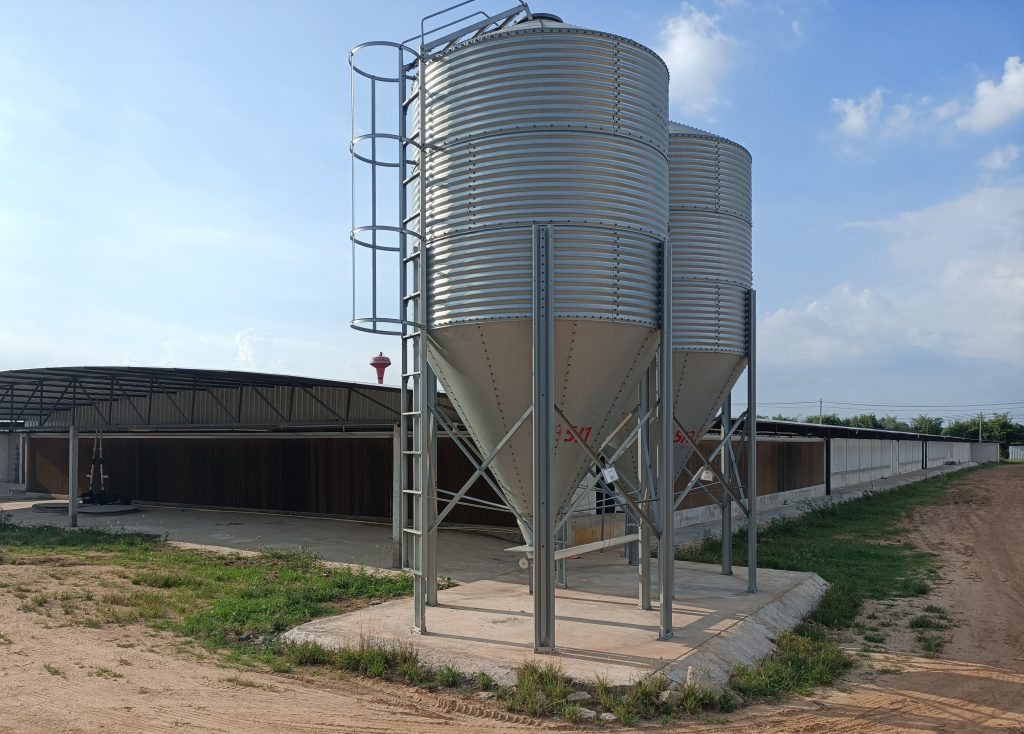
All industrial and manufacturing processes will use storage silos and hoppers and other vessels to hold material before it is sent to the next stage of production. Ideally, these are designed to prevent spoilage and contamination and allow easy maintenance and access.
However, there is another important factor: material flow. During storage or transfer, materials can settle, segregate, form clumps, or develop bridging and ratholing.
In this blog post, we will delve into the common vessels used in material handling and highlight the role of AirSweep in enhancing their efficiency, with insights from real-world case studies.
Silos
Silos are tall, cylindrical containers that store bulk materials, such as grains, cement, or powders. These vessels are commonly used in industries that require large-scale storage. Silos offer advantages such as space optimization, ease of loading and unloading, and protection from external elements.
AirSweep can be installed on silos to ensure efficient material flow. Bunge, an agribusiness and food ingredient company based in the USA, had issues with rice bran bridging in their storage hoppers and silos. Workers had to hammer the vessels, which was ineffective and stressful for everyone in the factory. “It was like fingernails on the chalkboard. You wanted to get away from it,” said John Pappenheim, Bunge’s Maintenance Manager.
AirSweep solved material blocks (and noise!). Installation was also simple and inexpensive: they just attach the units with simple tools and connected them to their existing compressed air and electrical system. “Any electrician can wire it up. I would absolutely recommend it.”
Hoppers
Hoppers are smaller containers typically found at the beginning or end of a material handling process. They are used for feeding materials into a system or collecting and dispensing them. Hoppers are widely employed in industries like mining, construction, and agriculture.
Unfortunately, hoppers can often be the bottleneck in production because of material bridging and ratholing over the outlet. AirSweep can prevent these issues from occurring.
One of the world’s biggest manufacturers of rubber tires had issues with carbon black bridging in the weigh hoppers. The entire process would shut down because the rest of the machines were starved of raw materials. After installing AirSweep, the material flowed freely.
Chutes
Chutes are inclined channels or tubes designed for the controlled movement of materials from a higher to a lower level. They are commonly used for transferring bulk materials such as granules, coal, or sand.
AirSweep technology can be integrated into chutes to eliminate clogging, ensuring a smooth and uninterrupted flow of materials. Heidelberg Cement installed the system on their pipes and chutes to remove cement clinker—a very hot, hard substance that fluidizers, vibrators, or even air cannons couldn’t remove. AirSweep was the only flow aid that worked.
Conveyor Systems
Conveyor systems are widely used in industries to transport materials horizontally or vertically. They consist of belts, rollers, or chains to move goods efficiently.
AirSweep systems can be strategically placed along conveyor belts to tackle material flow issues, such as accumulation or blockages. The pulsating bursts of compressed air from AirSweep devices help dislodge any lodged or stuck materials.
Cyclones
Cyclones, also known as cyclone separators, are vessels used in material handling systems to separate particles from a gas or liquid stream. They are commonly utilized in industries such as chemical processing, power generation, and mining. Cyclones employ centrifugal force to separate solid particles from the gas or liquid flow.
AirSweep is proven to improve cyclone efficiency. A plastic and chemical manufacturer had frequent production delays because of the build-up of adipic acid in their cyclone. It developed a cake-like crust that blocked the upper discharge and restricted material flow. Additionally, the product-laden air failed to separate and return to the baghouse, resulting in valuable product being carried to the waste stream.
AirSweep solved the problem immediately. “The AirSweep was a success! We are already looking at retrofitting more units into a silo with the same material.”
Improve material flow in all your vessels
From storage silos and hoppers to chutes and cyclones, AirSweep technology eliminates flow issues and enhances productivity. Contact us to find out more about how you can incorporate it into your process.





Comments are closed